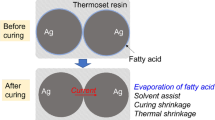Abstract
An important phenomenon in silver (Ag) particle-filled adhesives is the development of electrical conductivity as the polymer composite is cured. We report the results of optical and electrical measurements performed on a commercially available Ag particle/polymer composite as a function of sample temperature. Surface enhanced Raman scattering (SERS) was used to probe the chemical nature of the Ag interface while a four-point contact probe monitored the onset of DC electrical conductivity. Complementary to the die attach adhesives studies, SERS experiments were also performed on commercially available neat Ag flake with controlled adsorbate coverages. For both the neat flake and filled adhesive, a carboxylate layer was attached to an oxygen-covered Ag flake surface via the carboxylic acid end of the molecule. The SERS results observed a partial decomposition of the carboxylate species into an amorphous carbon layer upon an increase in the temperature of both the flake and filled adhesive samples. However, the temperature threshold for the chemical conversion was lower for the Ag-filled adhesive relative to the neat flake. In the composite samples, the formation of the amorphous carbon layer occurred well below the curing temperature and coincided with a corresponding decrease in the electrical resistivity of the adhesive. Thus, an initial step in developing electrical conductivity appears to be the partial conversion of the lubricant adsorbate to an amorphous carbon layer.
Similar content being viewed by others
References
Surface Enhanced Raman Scattering, edited by R. K Chang and T. E. Furtak,(Plenum, New York, 1982).
A. G. Brolo, D. E. Irish, and B.D. Smith, J. Mol. Struct. 405, 29 (1997).
I. I. Suni, J. Appl. Electrochem. 27, 1219 (1997).
J. I. Gersten and A. Nitzan, in Surface Enhanced Raman Scattering, edited by R. K Chang and T. E. Furtak (Plenum, New York, 1982), p. 89.
J. Miragliotta, R. C. Benson, and T. E. Phillips, MRS Symposium Proceeding vol. 445, edited by S. K. Groothuis, P. S. Ho, K. Ishida, and T. Wu, (Materials Research Society, Pittsburgh, PA, 1997), pg. 217.
J. H. Schachtschneider and R. G. Synder, Spectrochim. Acta 19 (1963) 117.
Infrared and Raman Characteristic Frequencies of Organic Molecules, edited by D. Lin-Vien, N. B. Colthup, W. G. Fateley, and J. G. Grasselli (Academic Press, New York, 1991), pg. 356.
J. L. Delarbre, E. Fabreque, L. Maury, and L. Bardet, J. Raman Spectro. 20 (1989) 41.
B. Sexton and R. J. Madix, Surf. Sci. 105 (1981) 177.
M. Moskovits and J. S. Suh, J. Am. Chem. Soc. 107 (1985) 6826.
E. H. Lee, D. M. Hembree, Jr., G. R. Rao, and L. K. Mansur, Phys. Rev. B48 (1993) 15540.
R. L. Opila and J. M. Worlock, J. Electrochem. Soc. 133 (1986) 974.
Author information
Authors and Affiliations
Rights and permissions
About this article
Cite this article
Miragliotta, J., Benson, R.C., Phillips, T.E. et al. Optical Probes and Electrical Resistivity Measurements of Conductive Die Attach Adhesives. MRS Online Proceedings Library 515, 245–250 (1998). https://doi.org/10.1557/PROC-515-245
Published:
Issue Date:
DOI: https://doi.org/10.1557/PROC-515-245



